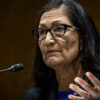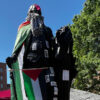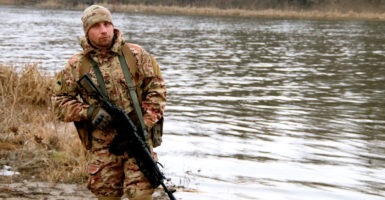KYIV, Ukraine—And it goes on and on in eastern Ukraine. Every day and every night. There’s never any end to the artillery, the rockets, the snipers.
Or the killing.
The war in Ukraine has so far killed more than 10,300 Ukrainians, including at least 2,523 civilians, according to the United Nations.
“After three and a half years, we are sadly further away from resolution than ever. The end seems not in sight,” Alexander Hug, principal deputy chief monitor of the OSCE Special Monitoring Mission to Ukraine, told reporters Friday in Kyiv via Skype.
The Organization for Security and Cooperation in Europe, or OSCE, is the multinational group charged with monitoring the cease-fire in Ukraine, known as Minsk II.
Like any war, the one in Ukraine is full of sad stories. There’s been no end to those, either.
The unlucky civilians killed by forgotten land mines, like the four who died when their minivan drove over a mine on Feb. 10, 2016, as they waited at a checkpoint to leave separatist-controlled territory.
Or, the grandmother on her way home from the market in the front-line town of Avdiivka on Feb. 1, struck down by shrapnel from a mortar. The 24-year-old daughter left kneeling in the snow over her mother’s body.

Ukrainians protest against corruption in central Kyiv—most Ukrainians consider corruption to be a threat to their country on par with that of Russia’s proxy war in the east. (Photos: Nolan Peterson/The Daily Signal)
The two children who became orphans in Avdiivka on May 13 when a shell landed in the front yard of their home while their parents were outside talking to a neighbor.
The seven civilians killed when a Russian Grad rocket attack pummeled a funeral procession in the town of Sartana on Oct. 14, 2014.
The 19-year-old volunteer soldier whose mother begged him not to go to war, killed by a Russian mortar that landed in his trench in the town of Pisky on Aug. 6, 2015.
The 298 people whose bodies fell to the earth in a lonely field in eastern Ukraine on July 17, 2014, after a Russian surface-to-air missile shot down Malaysia Airlines Flight 17.
And it goes on and on.
“The situation in Ukraine, unfortunately, is not getting any better and so we’re talking about it once again,” U.S. State Department spokesperson Heather Nauert reportedly told reporters in Washington on Wednesday.
“The United States continues to be deeply concerned by the escalating violence and the worsening humanitarian situation in eastern Ukraine,” Nauert said. “The decision to end the violence in eastern Ukraine and secure better relations with the United States and the international community lies squarely with Russia.”
A Forgotten War on Europe’s Doorstep
The war in Ukraine hardly makes the headlines anymore, if it ever did.
The war is not a particularly big one. Conventional combat operations are confined along a static, 250-mile-long front line in Ukraine’s embattled southeastern Donbas region. Although, Russia’s hybrid tactics—like cyberwarfare and weaponized propaganda—affect the entire country.
Nor is the Ukraine war the most deadly in the world today. The more than 10,300 Ukrainians who have so far died in the conflict pale in comparison to the approximately 400,000 people who have reportedly died in the six years of the Syrian war.
Yet, it is a war—the only ongoing one in Europe, in fact.
And if one were to draw a line back to the origins of Russia’s current hybrid conflict against the West, it would lead straight to the war in Ukraine.
“This is the front line of new generation warfare,” retired U.S. Army Gen. Jack Keane said of the war in Ukraine at a talk in Kyiv on Monday.
Russia invaded and seized Ukraine’s Crimean Peninsula in March 2014, and then launched a proxy war in eastern Ukraine the following April.
In turn, the United States and the European Union levied punitive economic sanctions on Moscow for its aggression in Ukraine.
Since then, relations between Russia and the West have hit a post-Cold War nadir.
Using cyberwarfare and an empire of weaponized propaganda, Russia has since 2014 embarked on a hybrid war blitz against Western democracies intended to undercut the stability of the post-World War II world order, in which the U.S. and its democratic allies have steered the course of history.
“Russia clearly is dangerous, very capable, and has significant geopolitical ambitions that are on a collision course with the international order; as we had for more than 70 years,” said Keane, who is chairman of the board at the Washington-based Institute for the Study of War.
On Wednesday, the EU announced it is extending its sanctions against Russia for at least six more months.
In a post on his official Facebook page, Ukrainian President Petro Poroshenko called the EU’s sanctions extension “an important political decision by the leaders of the European Union to continue economic sanctions against Russia for violating Ukraine’s territorial integrity and unwillingness to stop hybrid aggression against our country.”
A History of Violence
The Ukraine conflict began in April 2014 when Russian intelligence agents and special operations forces orchestrated a separatist uprising in Ukraine’s eastern Donbas region, spawning two breakaway republics.
In the intervening years, Russia has fanned and sustained the conflict by supplying its two proxy territories in the Donbas with weapons shipments and sending its own troops into combat against Ukrainian forces.
Consequently, Russia and Ukraine have been in a de facto state of war for nearly four years. Be that as it may, Moscow denies its involvement in the war, and Kyiv, for its part, calls its military operations in the Donbas an “anti-terrorist” operation.
“Russia initiated and continues to fuel the war in eastern Ukraine,” Harry Kamian, chargé d’affaires, a.i. of the U.S. Mission to the OSCE, told the OSCE Permanent Council in Vienna on Thursday.
“The Russian Federation has the ability to end the violence,” Kamian added.
After four years of constant combat, about 60,000 Ukrainian troops remain engaged in a static, trench warfare conflict against a combined force of about 35,000 pro-Russian separatists, foreign mercenaries, and Russian regulars.
It’s a long-distance conflict, mainly fought with indirect fire weapons, in which the opposing camps rarely see each other.
The war, while not over, is moderated in intensity and scale by the February 2015 Minsk II cease-fire. Among other measures, the cease-fire agreement proscribes heavy weapons above certain calibers within a buffer zone on either side of the contact line. Yet, those banned weapons are still used daily.
“We have seen more violence, less implementation of the Minsk agreements,” said Hug, the OSCE’s point man in Ukraine, adding that the two sides of the conflict are “not closer to ending this violence.”
“They are, in fact, further away than ever,” Hug said.
Whodunit
So far this year, OSCE cease-fire monitors have recorded more than 325,000 cease-fire violations in Ukraine, including 27,000 violations that involved the use of heavy weapons proscribed from the front lines by Minsk II.
Separatist officials claim Ukrainian government forces are the aggressors.
Yet, according to the OSCE, combined Russian-separatist forces commit the majority of cease-fire violations. Ukrainian forces say that when they break the cease-fire, they do so in self-defense.
This week, U.S. officials’ rhetoric underscored a growing frustration in Washington with Moscow’s role in the Ukraine conflict, particularly as conditions on the ground in the Donbas continue to deteriorate.
“We again call on Russia to stop artillery and rocket attacks against Ukrainian civilian areas and to honor the cease-fire called for in the Minsk agreements,” Nauert, the State Department spokesperson, said Wednesday in Washington.
At an OSCE Foreign Ministers meeting this week in Vienna, U.S. Secretary of State Rex Tillerson unequivocally called out Russia’s role in the Ukraine conflict.
“We should be clear about the source of this violence,” Tillerson said Thursday in Vienna. “Russia is arming, leading, training, and fighting alongside anti-government forces.”
Tillerson singled out the war in Ukraine as the paramount obstacle for U.S.-Russian relations.
“The issue that stands in the way is Ukraine,” Tillerson said, adding: “We can have differences in other arenas, in Syria. We can have differences in other areas. But when one country invades another, that is a difference that is hard to look past or to reconcile.”
In Moscow, officials maintained their line that Russia was not involved in the war.
“Russia is not present on the territory of Donbas, that’s why we consider that such words are inappropriate and wrong,” Kremlin spokesman Dmitry Peskov said Wednesday, according to the Russian news site TASS.
Unfinished Business
As the conflict in the Donbas goes into its fifth calendar year, its direct effects remain geographically quarantined from the rest of the country.
Ukraine is not a country at war. Russia’s proxy separatist territories comprise roughly 5 percent of Ukraine’s total landmass, and the war’s physical consequences only extend beyond the contact line as far as the range of the weapons used.
In cities hundreds of miles distant from the front lines, you’d hardly know this was the country in which Europe’s only land war is ongoing.
Life goes on. After all, for most Ukrainians not living in the war zone, the country’s post-revolution economic downturn and the tumbling value of the national currency have been more painful burdens to bear than the war.

A protest in central Kyiv on Dec. 5 underscores simmering discontent in Ukraine for a lack of progress on anti-corruption reforms.
Polling suggest that many Ukrainians see lingering governmental corruption as a threat on par with Russia’s proxy war in the Donbas.
According to an August poll by the International Republican Institute, a Washington think tank, 51 percent of Ukrainians surveyed rated corruption within state bodies as one of the three top issues facing the country, tied with the military conflict in the Donbas at 50 percent.
Meanwhile, what was once an acute humanitarian crisis in the eastern war zone has devolved into a long-term catastrophe.
For one, people keep dying. The United Nations reported 544 conflict-related civilian casualties, including 98 deaths, in the Donbas from Jan. 1 to Nov. 15 this year—a 3.6 percent increase over the same period in 2016.
This year’s number of civilian deaths, however, has so far gone up by 11 percent from 2016.
“The humanitarian situation in eastern Ukraine is … the worst it has been now in three years and it is deteriorating,” Nauert said Wednesday. “More than 1 million people in Donbas region are food insecure, civilian casualties are up significantly over last year.”
Land mines and booby traps have become a lethal threat for civilians, accounting for more than half of civilian casualties this year. According to a Nov. 17 United Nations report, at least 600,000 Ukrainians live in “mine-contaminated” areas.
“Ukraine is fast becoming one of the world’s most mine-contaminated countries,” the report said.
Powderkeg
Since 2014, Eastern Europe has militarized at record pace to defend against what countries in the region perceive to be an existential military threat posed by a revanchist Russia.
“Eastern Europe is expected to be the fastest-growing region in the world in 2018 in terms of defense spending,” Craig Caffrey, a senior analyst at IHS Jane’s, told The Daily Signal.
“Russian actions in Ukraine have been the catalyst,” Caffrey said, adding that by next year, defense spending among the three Baltic states will have more than doubled in real terms compared with 2014 levels.
Between 2014 and 2017 Eastern European defense spending rose by 34 percent in real terms, which is the largest increase of any region in the world.
“Most of the new money is going into modernization and readiness, so this will have a direct impact on military capabilities throughout the region,” Caffrey said.
Ukraine, for its part, has rebuilt its armed forces into the second-biggest standing army in Europe, with about 250,000 active-duty troops and tens of thousands more in reserves. In terms of manpower, only Russia’s military is bigger among European countries.
Ukraine has a long way to go to modernize its military arsenals and institutions to be on par with NATO countries. Poroshenko, however, has set a deadline for the year 2020 to do just that.
In 2017, Ukraine’s defense spending represented 6 percent of its gross domestic product—well surpassing NATO’s minimum defense spending benchmark of 2 percent of GDP. That’s a sharp jump from 2012, when Ukraine spent the equivalent of about 0.6 percent of its GDP on defense.
And, according to Ukrainian news reports, Ukraine’s 2018 budget calls for a 28 percent increase in defense spending over 2017—up to $6.1 billion in total.
Despite the boost, Ukraine’s projected 2018 defense and security budget is roughly the price tag of one U.S. Navy Nimitz-class aircraft carrier.
Caffrey pointed out that Ukraine would have to spend roughly 40 percent of its GDP on defense to match Russia’s defense budget, forecast to come in at around $47.13 billion in 2018, according to IHS Jane’s.
“From a defense spending perspective, I don’t think Ukraine is trying to become a counterweight to Russia, largely because that’s unachievable given the disparity between the Russian and Ukrainian economies,” Caffrey said.
Still, Ukraine’s upped defense spending underscores how the country now sees Russia as a long-term military adversary—a falling out between the two post-Soviet countries and erstwhile allies that has sent shockwaves across the region.
“The Western community must avoid viewing the Kremlin’s war in Ukraine as a singular military crisis. Rather it should view it as a symptom of wider regional geopolitical and economic issues,” Franklin Holcomb, a Russia and Ukraine analyst at the Institute for the Study of War, told The Daily Signal.
Russia’s “little green men” invasion of Crimea in 2014 could be a bellwether for the kind of offensive military operation Russia would conduct against NATO’s Baltic member countries.
Consequently, U.S. military forces in Europe are leaning forward to anticipate how Russia might integrate multiple war-fighting domains into a combined hybrid offensive.

A U.S. Army exercise in Estonia in 2015, underscoring U.S. commitment to defend its NATO allies from Russian aggression.
At a training exercise in Estonia this June, for example, U.S. Air Force A-10 “Warthog” warplanes landed on a rural highway, simulating an airfield seizure operation. At the same time, U.S. and Estonian cyberwarfare personnel at a nearby air base simulated defending against a cyberattack on the A-10s’ maintenance software.
The interwoven use of a Cold War-era weapons system like the A-10 with cyber operations foreshadows the kind of complex, multidimensional defensive combat tactics the U.S. and its NATO allies need to develop to counter Russian hybrid warfare threats.
According to NATO’s collective defense agreement, an attack against a member state is considered to be an attack against all NATO allies. Meaning a Russian attack on one of the three Baltic countries, which are all NATO members, would spur a U.S. military response.
Parting Thought
As U.S. military forces in Europe repaint their desert tan equipment in forest green, there’s a feeling of déjà vu among those few troops who can remember the Cold War.
Similarly, as the intermittent rattle of machine guns and the sporadic crack of artillery thunders across the frosted plains of eastern Ukraine, one remembers that just two generations ago this land was the deadliest battlefield of the deadliest war in human history.
The current war in Ukraine is nothing less than a sword of Damocles suspended over Eastern Europe, threatening to spark a larger conflagration.
While covering the Spanish Civil War in 1938, the American author Ernest Hemingway wrote an article in which he commented on a series of photos of fallen Spanish Republican soldiers who had died fighting against nationalist forces supported by Nazi Germany and Fascist Italy.
“Perhaps,” Hemingway wrote, “these pictures will make it seem a little more real. Because these pictures are what you will look like if we let the next war come.”
World War II began the next year, and more than 400,000 Americans died in it.
Tonight, there are roughly 60,000 Ukrainian troops deployed in the frigid trenches and embattled front-line villages of eastern Ukraine.
When the sun goes down on this night, the tracers will cut across the dark sky up and down the 250-mile-long front line. War-weary soldiers and civilians will hunker down in trenches and in cellars, staving off the cold and the fear as they have for four winters now.
There’s a 1 in 3 chance a Ukrainian soldier will die tonight on that lonely, frigid battlefield at the hands of a Russian weapon. There’s a good chance a civilian will be killed or wounded tonight, too.
The war goes on and on. When, and where, will it end?




























